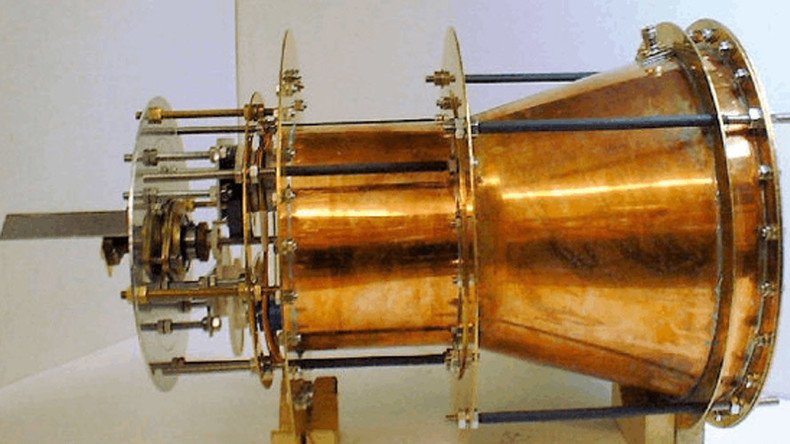EmDrive thruster that could revolutionize space exploration defies laws of physics – NASA paper

NASA’s Eagleworks paper on EmDrive space propulsion technology has finally been published. It shows that the electromagnetic drive rocket propulsion system actually works, but seemingly violates Newton’s Third Law of Motion.
First proposed in 1999, the EmDrive uses electromagnetic waves as fuel and bounces microwaves inside a cone-shaped metal container to create thrust.
A leaked version of the long-awaited report was released on a NASA Spaceflight forum earlier this month, but the peer reviewed open source paper, entitled “Measurement of Impulsive Thrust from a Closed Radio-Frequency Cavity in Vacuum,” has now been published by the American Institute of Aeronautics and Astronautics (AIAA).
Pull on #Pluto’s ‘icy heart’ shifted dwarf planet’s axis – studies https://t.co/p7HUZSXVyrpic.twitter.com/yeC3Fyu4YO
— RT (@RT_com) November 17, 2016
Although the level of thrust was quite low, it has been revealed that the NASA Eagleworks lab was consistently able to generate 1.2 millinewtons per kilowatt of thrust in a vacuum.
“Thrust data from forward, reverse, and null suggested that the system was consistently performing at 1.2 ± 0.1 mN∕kW, which was very close to the average impulsive performance measured in air,” the paper reads, adding “a number of error sources were considered and discussed.”
The EMDrive is a time machine as well as a "teleporter" as well as a space warp drive. We will venture out. pic.twitter.com/GZmnJgzSXW
— SFC John Titor (@JohnRenzi2036) November 18, 2016
The system apparently defies Newton’s third law, which holds that everything must have an equal and opposite reaction. Generating thrust momentum in one direction requires something to be expelled, such as a propellant or exhaust, but the EM Drive doesn’t do this.
The paper doesn’t explain how this is possible, but suggests the “supporting physics model used to derive a force based on operating conditions in the test article can be categorized as a nonlocal hidden-variable theory, or pilot-wave theory for short.”
The team behind the paper were testing to see if the drive actually works, rather than striving to attain the greatest performance, meaning that the system can likely be made even more efficient.
Mysterious ‘sphere’ spotted in NASA’s Sun images (VIDEO) https://t.co/Er6MN9y37Npic.twitter.com/dC9yUKGMVQ
— RT (@RT_com) November 20, 2016
Should the EM Drive be found to work, it would advance space exploration by eliminating the need for heavy rocket fuel, allowing for lighter space vehicles that could take astronauts as far as Mars more quickly than possible with current technology.
The paper notes that more research is needed to determine exactly how EmDrive actually works, and whether it is really producing thrust, as it’s possible that thermal expansion may be affecting the results.
The EmDrive is scheduled to be tested in space in the next few months. Should it work there, skeptics in the science community will have to figure out how the drive generates thrust without exhaust.













